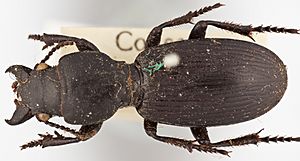Mecodema curvidens facts for kids
Quick facts for kids Mecodema curvidens |
|
|---|---|
 |
|
| Scientific classification | |
| Genus: |
Mecodema
|
| Species: |
curvidens
|
The Mecodema curvidens is a type of ground beetle. It was first described by Thomas Broun in 1915. This beetle is found across the central parts of the North Island in New Zealand.
You can find it in many areas. These include Auckland (AK), Waikato (WO), Coromandel (CL), Bay of Plenty (BP), Taupo (TO), Rangitikei (RI), Whanganui (WI), Hawkes Bay (HB), and Wellington (WN).
Recently, scientists decided that another beetle, M. occiputale, was actually the same species as M. curvidens. So now, they both share the same name. This beetle is quite common in most of its home range. However, it is less common in the southern Hunua Ranges (near Auckland) and in the Wellington region.
What Makes This Beetle Special?
It can be tricky to tell different Mecodema beetles apart. But the Mecodema curvidens has a few special features. These help scientists know it's this specific species:
- It has 4 to 6 tiny hairs, called setae, on each side of its pronotal carina. The pronotal carina is a ridge on the beetle's back, near its head.
- It has a narrow groove on its head, called a vertexal groove. This groove is clear and goes all the way along its length.
- The shape of a part called the basal lobe is unique. Also, the way the hairs are spread along the bottom edge of its left paramere is special. These are parts of the beetle's body that help identify it.
How Big Is This Beetle?
The Mecodema curvidens is a medium-sized beetle. Its body length can be from 18 to 26 millimeters. That's about the length of two small paperclips.
The width of its pronotum, which is the shield-like part behind its head, is about 5.4 to 7.53 millimeters. Its elytra, which are its hard wing covers, are about 6.13 to 8.56 millimeters wide.
The whole body of this beetle is shiny or matte black. But its legs, from the coxae (the part closest to the body) to the tarsi (the feet), can be reddish-brown or black.
See also
 In Spanish: Mecodema curvidens para niños
In Spanish: Mecodema curvidens para niños

